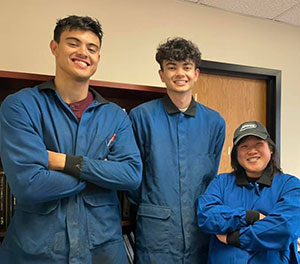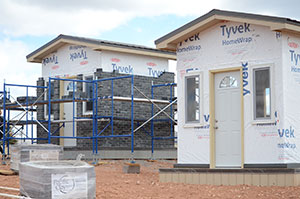
The Center for Carbon Capture and Conversion (CCCC) in the University of Wyoming’s School of Energy Resources recently broke ground on a demonstration house made of coal-derived carbon building materials and char bricks.
The house is being built in tandem with a second house made from conventional building products and Pacific Clay bricks. The coal-derived bricks are made using low-energy, eco-friendly process technologies developed in the CCCC.
“The goal of the project is to see how the coal-derived building materials, especially char bricks, stand up to different environmental conditions and compare to conventional building materials that are currently used in the market,” says ChooiKim Lau, the UW Department of Civil and Architectural Engineering and Construction Management graduate student leading the project. “Our team will evaluate performance characteristics, such as the mechanical integrity, thermal resistance, light weight, fire resistance, toxicity and electromagnetic radiation tolerance, with comparative durability, noise resistance, moisture absorption and weathering.”
Originally from Alor Setar, Malaysia, and now a resident of Laramie as a U.S. citizen, Lau is working alongside undergraduate students Noah Scott and Jon Scott, of Cheyenne. They work under the direction of Kam Ng, an associate professor in the UW Department of Civil and Architectural Engineering within the College of Engineering and Applied Science. The goal of the demonstration is to showcase the various building materials that are made from Wyoming coal and, in particular, the coal-derived char bricks.
Focusing on the future of Wyoming coal, the project is part of the Carbon Engineering Initiative in the CCCC dedicated to discovering and advancing new uses for coal by making commodity products that are nonenergy and fuel based.
In addition to the char bricks, researchers at UW have developed a multitude of coal-derived building materials, including mortar, plaster, flooring materials, roofing materials, insulation materials and structural units to supplement concrete, timber and steel.
“The goal is to ultimately utilize all of these materials to build a completely coal-derived carbon-based house,” Ng says. “While the other materials are in varying stages of development, the char bricks are well advanced and to the point that we can really find out how they compare to the industry-standard clay bricks, and also determine how well they work with existing construction materials and in conventional building designs.”
In summer 2021, the team manufactured over 4,000 coal-derived char bricks in the span of 30 days using basic tools and equipment. The bricks were produced using a zero-waste construction method in which they can be manufactured, transformed and recycled in a comprehensive life cycle, minimizing residual materials.

“Our bricks are completely sustainable and unique, in that they are created from coal byproducts,” Lau says. “We use pyrolyzed char from coal as the feedstock for the bricks. The char is one of the byproducts from processing coal through an integrated pyrolysis and solvent extraction process. Furthermore, lower-quality bricks can be broken down and recycled as feedstock to make new, high-quality bricks.”
The initial findings regarding the properties of the char bricks show attributes that are superior to clay bricks. They are lighter weight, provide better insulation and have the ability to regulate the moisture content in the building.
“The porosity and thermal properties of the coal char bricks are such that they have the ability to absorb moisture from inside buildings on humid days and release moisture on dry days, which means that the building is consuming less energy,” Lau says. “Additionally, according to the industry-standard fire endurance test, char bricks receive a rating of Class A, which is the highest score possible.”
The char bricks also are more economical to produce. The team made each individual brick by hand and used the Wyoming summer sun to dry and cure the bricks, bypassing the costly firing process used in the manufacturing of clay bricks.
Richard Horner, the CCCC’s director, says products derived from coal are an extremely important step forward for Wyoming.
“Our objective in the School of Energy Resources is not just to do research, but also to commercialize these efforts and create new jobs and industries in Wyoming,” Horner says. “Currently, coal is a main source of income for the state, so efforts to keep mines operating will allow us to have a continued revenue stream for our state to invest in education, infrastructure, medical care, emergency services and the overall well-being of Wyoming citizens.”
The efforts also will play a major role in growing Wyoming and creating diversification opportunities in the manufacturing industry, he says.
“The people in Wyoming coal communities have extensive knowledge of our coal and reserves and, therefore, their skills are very valuable,” Horner says. “The more mines we keep open, the more jobs we retain, and, in the event a mine closes, we hope to have created a new employment opportunity in the manufacturing sector.”
Once construction of the demonstration houses is completed, the team will carry out yearlong performance monitoring tests to provide a good baseline to see how the coal-derived building materials outperform the conventional building materials. The data and results then will be shared with interested industry partners, with the hope they’ll take the technology to market.
The team is optimistic about the feasibility for the scale-up or mass production of this technology.
“We are eager to gather performance data on our building materials,” Ng says. “We hope that our research will highlight the competitive advantages of our coal-derived char bricks to the construction industry and increase the products’ marketability, usage and consumption, further advancing to the next stage of commercialization and production.”
For more information on the demonstration house and other coal products, visit the CCCC website.

